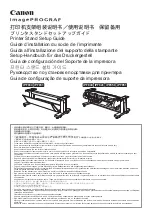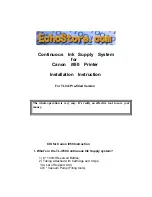
Section 2: Operating Instructions
AP-CC30 Concrete Claw 328-160MK
11/11/19
10
Section 2: Operating Instructions
Operating Checklist
Hazard control and accident prevention are dependent
upon the awareness, concern, prudence, and proper
training involved in the operation, transport, storage, and
maintenance of the Concrete Claw. Therefore, it is
absolutely essential that no one operates the Concrete
Claw unless they are age 16 or older and have read, fully
understood, and are totally familiar with the Operator’s
Manual. Make sure the operator has paid particular
attention to:
•
Important Safety Information
, page 1
•
•
Section 2: Operating Instructions
, page 10
•
Perform the following inspections before using your
Concrete Claw.
Make the following inspections after attaching the
Concrete Claw and shutting down the power machine
properly.
1. Shut power machine down before dismounting.
“Power Machine Shutdown Procedure”
2. Complete Operating Checklist table provided above.
3. Inspect Concrete Claw. Make sure it is in good
working condition and that all safety alert decals are
visible and readable. Replace any safety decal that is
not visible or readable. Refer to
4. Inspect hitch hook-up. Make sure the loader hitch is
secured under the Concrete Claw’s top angle bars,
lock pins are fully extended through the bottom slots
in the attachment’s hitch plate, and manual lock pin
levers, if included, are locked down.
5. Consult your power machine Operator’s Manual to
determine if ballast is required. Add ballast if needed.
6. Operate Concrete Claw through its full range of
movements to check for clearances. Refer to
Operating Checklist
Check
Ref.
Make sure all power machine guards & shields
are in place and secure. Refer to your Power
Machine Operator’s Manual.
Check initially and periodically for loose or
missing components.
Refer to “Replace Pin-on Teeth”.
Operating Safety
DANGER
!
To avoid serious injury or death:
•
Always secure equipment with solid, non-concrete supports
before working under it. Never go under equipment
supported by concrete blocks or hydraulics. Concrete can
break, hydraulic lines can burst, and/or hydraulic controls
can be actuated even when power to hydraulics is off.
•
Keep attachment, loader arms, and/or load away from
overhead electrical power lines. Place an orange warning
sign under overhead lines indicating type of danger above.
•
Keep bystanders away while operating the attachment. A
person can become pinched or crushed as the attachment is
rotated, raised, and/or lowered.
•
The operator of this attachment must know how to control
the power machine with attachment and how to stop them
•
Use a “spotter” when it is hard to see in the direction you
are traveling and when placing a load that obstructs your
vision. A person or animal could be nearby in a blind spot.
•
Do not drive up to anyone or an animal in front of a fixed
object such as a wall or bench. Never assume that the power
•
Keep bystanders, pets, and livestock away from your work
area. Never allow anyone to go near or under the
attachment or its load. The attachment and/or load can fall.
•
Be safe, lift only loads with the loader arms that can be kept
under control and contained. An uncontrolled load can
result in a serious injury or death.
•
Make sure the load can be kept under control and is stable
in the attachment before traveling to the dump site.
•
Keep load slightly tilted back to secure its weight against
the hitch frame. Tilting top of hitch frame to far back can
cause load to shift and fall rearward onto the machine and/
or operator. Tilting top of hitch frame to far forward can
cause load to shift and fall forward.
•
Never dump a load around gas lines, overhead power lines,
utilities, or other hazards that can cause serious injury or
death from electrocution, explosion, or fire.
•
Raise loader arms only high enough to release the load
onto the ground or pile.
•
Do not go near or under raised loader arms without first
securing loader arms in the raised position with an
•
Keep your head, arms, and legs inside the cab while
operating the power machine. Any extremity extended
outside the cab can be crushed by the loader arms and
•
Never operate equipment from outside the cab.
•
Use the power machine’s alternate emergency exit when
exit passage through the front is blocked.
•
Do not use hand or foot controls for handholds or steps.
Using them for handholds or steps can activate the controls.














































